In Tamil Nadu, an encumbrance, also known as a “villangam” certificate or an “EC certificate”, proves your complete ownership of a property. You can apply for this certificate online in Tamil Nadu.
Before buying land in Tamil Nadu, buyers of real estate must make it a point to look at the encumbrance certificate. The sub-registrar in Tamil Nadu whose jurisdiction the property is under is the one who issues the encumbrance certificate. When a property is bought or sold, it is registered here.
An encumbrance certificate (EC) establishes the existence of any form of control over a piece of property by a party other than the original owner. For instance, the encumbrance certificate would indicate that a property is encumbered if it has a mortgage with a bank and that the bank has an interest in it. The document is also referred to as a “villangam” certificate in the state.
In Tamil Nadu, you can submit an online application for an encumbrance certificate by going to the Inspector General of Registration (IGRS) Tamil Nadu or TNREGINET website. The portal was created by the Tamil Nadu government to make it simpler to register for events like marriage, birth, death, firms, chit funds, etc. The portal provides access to services like encumbrance certificate search and property valuation. All you need to submit an online application for an EC is information like your name, address, zone, district, SRO, street name, village, house details, and the proper extent and boundaries of the property. This article will explain how to obtain an online encumbrance certificate. Encumbrance certificates (EC) for business enterprises are issued by the Registration Department.
Encumbrance certificate: what is it?
A legal document known as an “encumbrance certificate” contains information regarding property ownership, transactions, and associated information. It is issued by the sub-registrar under whose jurisdiction the property is located. The encumbrance certificate, or EC in Tamil Nadu, is a legitimate proof to determine whether an entity is the original property owner and aids in avoiding legal disputes.
How to obtain an EC or an encumbrance certificate online in Tamil Nadu?
Step 1: You must register on the TNREGINET portal in order to submit an online application for an EC. Sign in if you already have an account; otherwise, register to access the services and log in.

Step 2: If you are a first-time user, you must register and provide information such as a username, password, address, identification number (PAN, Aadhaar, driver’s license, or other), and contact information. Complete the registration to get an OTP on your contact number.
You will see the following screen after registering:

Step 3: Check for a verification link in your email from the authority.
Step 4: Once your information has been verified, you can access the TNREGINET portal.
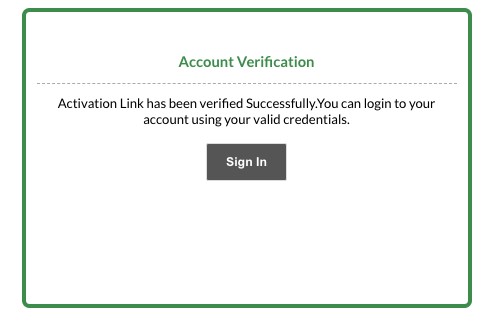
Step 5: A registered user can now access the Encumbrance Certificate search and application by going to the “E-services” tab on the homepage.
Step 6: You must complete the following information:
Location: Sub-registrar office, district, zone.
Time: The start and end dates for the EC.
Survey details: Details about the survey include the village, survey number, and subdivision number.
House details: Plot number, flat number, door number, ward, block, boundary details, extent, and build-up area.
Additional information: Old survey number, TS number, old door number, declared owner, father’s name, and any registered documents.
After entering these information, you can move on to entering the captcha to look up the Tamil Nadu EC/encumbrance certificate.
Step 7: After you click “Search,” all of the documents related to the information you entered will be shown. Click “Apply Online” to continue.
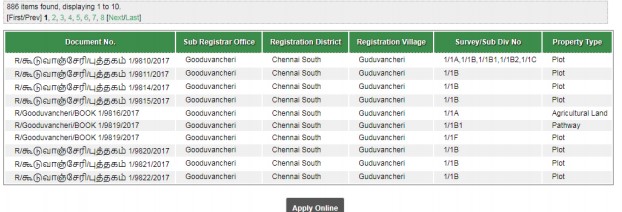
Step 8: Enter your name and contact information, save it, and then continue to the payment page.
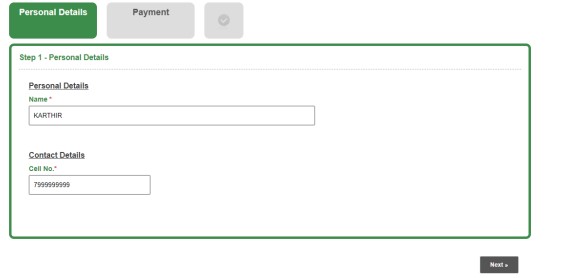
Step 9: Choose to pay to proceed to the screen for electronic payments.
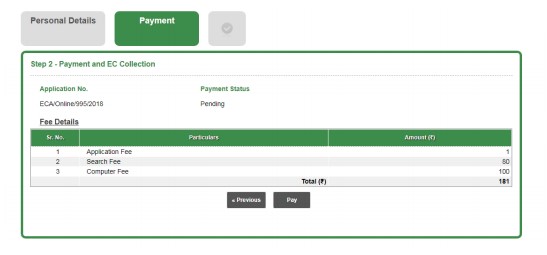
Step 10: Enter the details in the e-payment section such as name, address, sub-registrar office etc.
Step 11: Choose the bank you wish to make the e-payment from and pay.
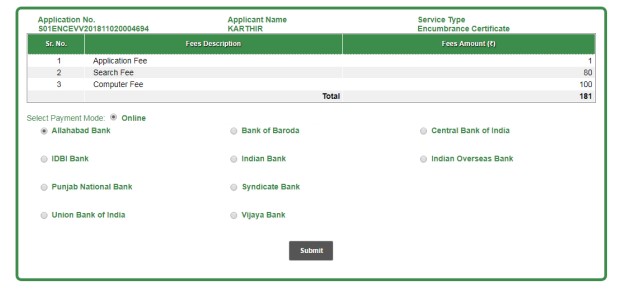
Step 12: Following the completion of your payment, you will receive a bank reference number, CIN number, and transaction ID. Keep these information handy. The encumbrance certificate will be sent to the applicant’s login with a QR code added in all the pages and a digital signature of the sub-registrar affixed at the end after the application has been selected for submission and approved by the sub-registrar. You will receive a SMS notification.

You can find the digitally signed online EC under E-services > Encumbrance Certificate > Request List is where.
How to obtain an offline TN EC or Villangam encumbrance certificate?
Documents needed to apply for an EC or Villangam certificate are listed below:
- Copy of address proof
- Property details
- Details about Title
You will also be required to pay the appropriate fee for these TN EC-related online services in addition to this.
Step 1: An application and the aforementioned documents must be delivered to the sub-registrar’s office. You can download the application format for the villangam certificate.
Step 2: The relevant authority will review all documents to determine their legality.
Step 3: An EC with all transaction information is issued, or a Nil Encumbrance Certificate is issued if there have been no transactions. Depending on when you apply, this could take 15 to 30 days.
How to use TNREGINET to search for a Tamil Nadu encumbrance or villangam certificate
Step 1: Visit the Inspector General of Registration (IGRS) Tamil Nadu’s (TNREGINET) official website.
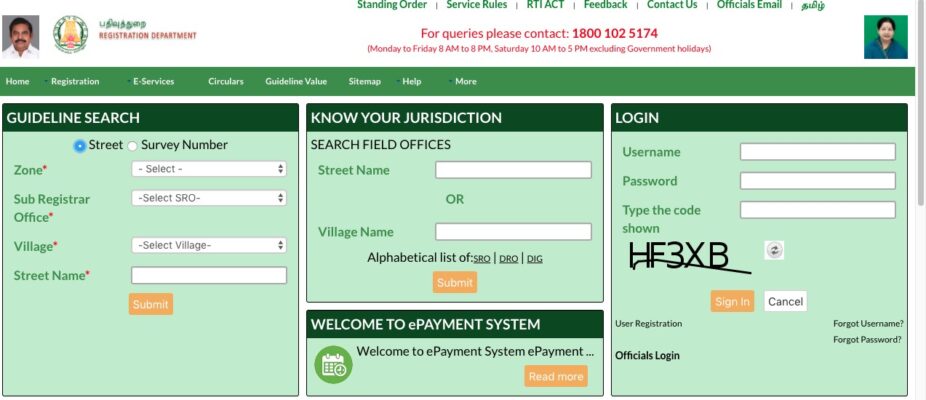
Step 2: Select the “ENCUMBRANCE CERTIFICATE” option from the list of services at the bottom of the page. Click on it to submit an online EC application. The same window can also be accessed by tapping the ‘e-services’ tab on the homepage.

Step 3: You will be taken to a page where you must enter information like your zone, district, sub-registrar office, EC start and end dates, survey details like your village, survey number, and subdivision number, as well as other details. Check your information and look for your EC/Villangam certificate by entering the captcha.
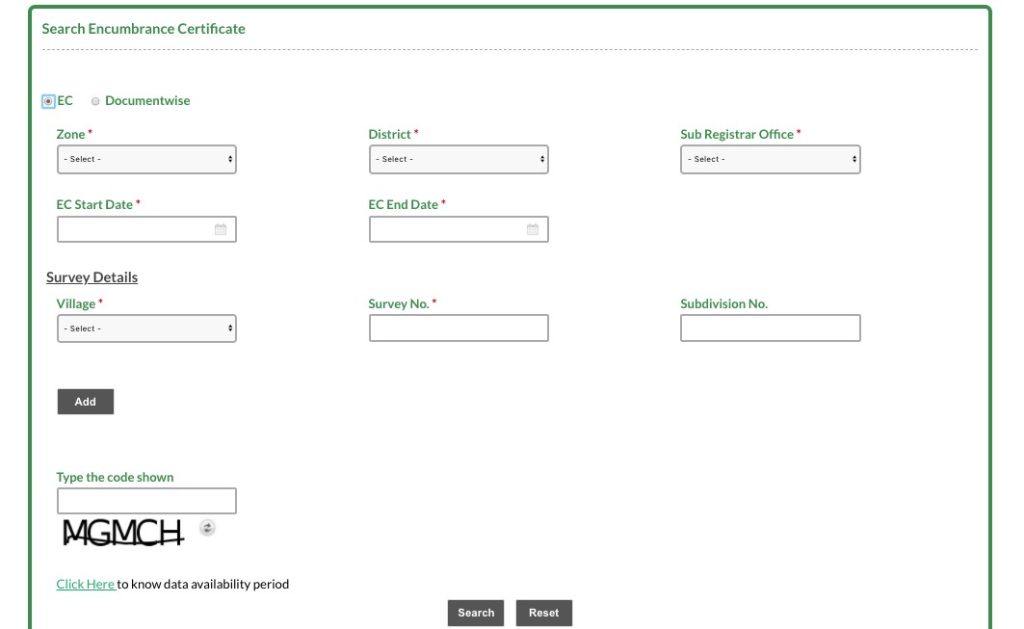
Step 4: On the screen above, you can also select the “document-wise” option. You will be required to provide information like the sub-registrar office, document type, year, and number. Enter the captcha, and then continue.
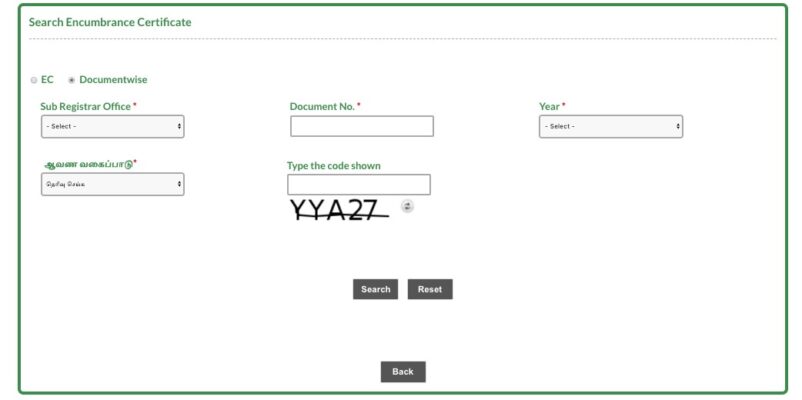
Click here to find out how long in Tamil Nadu data for an encumbrance certificate or villangam certificate will be available.
How to view an encumbrance certificate in Tamil Nadu online?
Follow these steps to view an encumbrance certificate online:
- Step 1: Visit the TNREGINET official portal.
- Step 2: Select the “Search/View EC” tab from the “Encumbrance Certificate” menu at the bottom of the home page. Alternately, you can select the “Encumbrance Certificate” option by first selecting the “E-Services” tab. After that, you must select “View EC”.
- Step 3: Tick the boxes next to “EC”, “Document-wise”, or “Plot-wise” to indicate the information that is required. Once you’ve entered the CAPTCHA, click ‘Search’. The Encumbrance Certificate will now be visible to you.
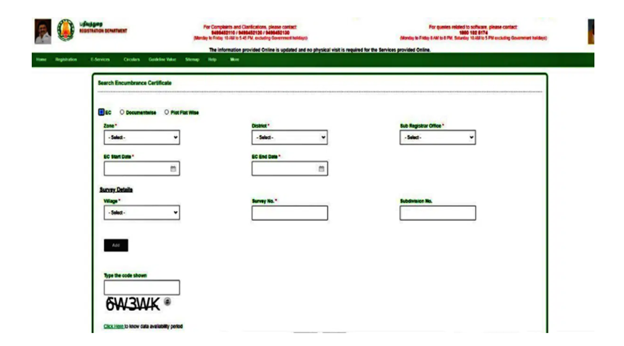
Format for applying for a encumbrance certificate
In order to request assistance with the application process for an encumbrance certificate, applicants must submit a straightforward formula proforma. The Registrar or Sub-Registrar, the Registrar or Sub-Registrar office, and the address must all be included in the letter.
The application must contain all pertinent property information, such as the full address as it appears in the registration deed and the east, west, south, or north boundaries to help identify nearby properties or landmarks. If you don’t have all the property information, the concerned officer may be able to assist you.
Encumbrance certificate-issuing states
Except for a few states, encumbrance certificates are primarily issued physically throughout India. Andhra Pradesh, Kerala, Odisha, Puducherry, Tamil Nadu, and Telangana are among the states that offer EC online services.
How long is an EC certificate valid?
An encumbrance certificate for a piece of property is available for up to 30 years. It is important to keep in mind that an EC requested for a specific period will only contain information for that period.
When is a certificate of encumbrance required?
Any financial or non-financial claims made against property by parties other than the titleholder are referred to as encumbrances.
A buyer must make sure the property has a clear title before making a purchase. The Encumbrance Certificate can be obtained to help confirm whether the property being considered for purchase is free of any financial or legal obligations, such as liens, unpaid loans, etc. Before moving forward with the purchase, it is necessary to address any charges on the EC. A potential buyer can find out if there are any current owners who have the ability to assert their legal rights over the property.
In addition, lending institutions may request the EC as part of loan against property and home loan applications.
In addition, EC documents may be required for property changes (Khata Registration, Khata Transfer, and Patta). The Village/Panchayat Officer is given the certificates to replace the land tax records in cases of non-payment of property or land taxes for more than three years.
For other reasons, such as the sale of the property, the withdrawal of PF for a property, home construction or purchase, etc., encumbrance certificates might be required.
Types of encumbrance certificates
The two types of encumbrance certificates are Form 15 and Form 16. If the property has any encumbrances during the time that an applicant has requested the certificate, the Sub-registrar’s office will issue the Form 15 document. On the other hand, if a property has not recorded any encumbrances during the period for which the application has made a request, the Sub-registrar’s office issues a nil-encumbrance certificate on Form 16.
What does the non-encumbrance certificate mean in Tamil Nadu?
When there are no transactions involving the property during the time frame for which an encumbrance certificate is required, a non-encumbrance certificate is issued in Tamil Nadu. This is also known as a Nil Encumbrance Certificate.
How to obtain digitally signed copy of the Tamil Nadu encumbrance certificate?
In Tamil Nadu, the process for obtaining a digitally signed copy of an encumbrance certificate has been made straightforward.
Select “E-services” from the drop-down menu after logging into the www.tnreginet.com portal.
Click ‘Search and Apply EC’ after selecting ‘Encumbrance Certificate’.
You will need to create an ID for that, log in to the www.tnreginet portal once more, and follow the same process as before. Pay for EC using the online payment gateway. The ‘Request List’ tab in the same menu will contain a link to the digitally signed online EC that can be downloaded. The following fee is required to obtain a digitally signed EC:
- Application fee for ECs: Rs 1.
- The first year’s search fees are Rs 15.
- The following year’s search fees are Rs 5 each.
- From 1987 onwards, during the Computerized Period, there was an additional fee of Rs 100.
Method of online payment
- Log in to the official website at https://tnreginet.gov.in.
- Create an NEFT/RTGS challan using the e-payment option.
- Fill out the necessary charges.
- Choose the SBI payment gateway. After that, select NEFT or RTGS.
- Print the NEFT/RTGS payment challan and use it to make a payment in any bank other than SBI.
- Log in and print the acknowledgement.
Offline payment method
The offline payment option entails paying the fees in person at bank branches. By logging into the portal and going to e-payment, one can pay using an offline challan. Fill out the necessary charges. Opt for the offline payment method. Create an offline payment challan, then pay with it at any bank branch. Verify the payment status by visiting the login page.
Avoid using the standard payment slips offered by State Bank of India, Indian Overseas Bank, Indian Bank, IDBI Bank, Central Bank of India, Punjab National Bank, Bank of Baroda, and Union Bank of India.
Tamil Nadu encumbrance certificate correction procedure
When requesting an encumbrance certificate in Tamil Nadu, one should always proceed carefully. Users must be aware of the rectification deed when applying for an online EC or encumbrance certificate in Chennai and other cities. If there is a mistake in your certificate, you must apply for a rectification deed and provide any supporting documentation that demonstrates the errors in the prior encumbrance certificate. An encumbrance certificate can only be changed in a minor way no significant alterations can be made. There is no way to modify the documents that have been filed with the sub-registrar’s office. Therefore, a rectification deed cannot be used to correct any error in the original documents.
Encumbrance Certificate Limitations in Tamil Nadu
In Tamil Nadu, an encumbrance certificate only includes information about the requested time period. An encumbrance certificate does not reflect any information from earlier than this time. Similar to this, an Encumbrance Certificate Tamil Nadu does not take into account any oral agreements or unregistered documents.
What is a nil encumbrance certificate?
A nil-encumbrance certificate will be issued if there have been no transactions involving the subject property during a specific time period for which an encumbrance certificate is requested.
Online encumbrance certificate: How to download the Villangam certificate?
Log in to the TNREGINET official portal and select the encumbrance certificate option to download the Villangam certificate. Click the “View EC” button after selecting Encumbrance Certificate from the E-Services tab. To create the encumbrance certificate, provide the necessary information. The Villangam certificate will be accessible for download.
When is an encumbrance certificate required?
The following situations would necessitate the use of an encumbrance certificate:
- When you are purchasing a property.
- To obtain a home loan in order to purchase a property.
- To withdraw money from the provident fund to pay for a house.
- For property mutation.
- For the sale of the property.
E-signed encumbrance and certified copies in Tamil Nadu
For e-signed encumbrances and certified copies in the state, the state government has given its approval. The change will bring the current system one step closer to modernization. The sub-registrars are solely responsible for enabling and facilitating this change.
A QR-enabled copy with the digital signatures of the relevant sub-registrars will be given to people who need encumbrance certificates and certified copies. Any official who knows the password can use the Aadhaar-linked e-sign. As soon as the sub-registrar places his or her thumbprint on the biometric device, the system will automatically recognize the sub-registrar’s Aadhaar number and encrypt the digital signature in the certificates.
How to encumbrance certificate in Tamil Nadu?
Visit the Tamil Nadu registration department’s official website. Follow the TNREGINET portal’s online EC viewing procedure. To view or download the encumbrance certificate, click the encumbrance certificate option. After that, you can download the Villangam certificate. Once the certificate is ready, you can also access it by scanning the QR code sent to your registered phone number or email.
Court litigations to be seen in EC
The Madras High Court recently ruled in what is being hailed as a rare decision that interested parties and potential buyers should have access to court decisions in the EC. Previously, buyers had to approach civil courts to remove disputed entries in jurisdictional civil courts, said Justice N Anand Venkatesh.
Tamil Nadu EC Online: Contact Information
Citizens can contact the helpdesk at [email protected].
You can also write to No. 100, Santhome High Road, Chennai, Tamil Nadu, India, 600028.
Follow and Connect with us: Twitter, Facebook, Linkedin, Instagram







